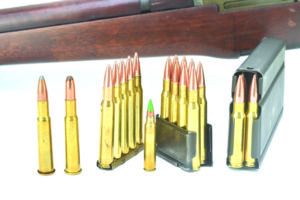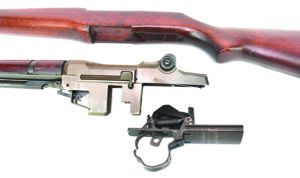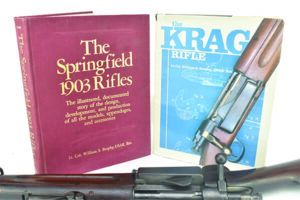Do you ever look at an old firearm and wonder what stories it could tell you? We do. So, we are going to bring you four rifles, all produced by Springfield Armory over a period of some 85 years, and tell you a few of their tales. Perhaps their back stories will light a spark of interest in you to look at one of these items for yourself.
First up is an 1898 Krag-Jorgensen that has been modified by various owners.
Next is a Springfield ‘03 with a receiver that dates to 1931 and the barrel to 1928. That one was rebuilt by the government around the end of World War II and still looks great.
This is followed by an M1 Garand that serial-number records show was built in 1943. This one was a Director of Civilian Marksmanship sale, and we see the barrel was replaced at some point.
The last is a National Match M1A we believe was produced in the mid-1980s. This M1A is a semi-auto version of the famous M-14 and was used by a long-deceased friend in NRA High Power matches over a number of years.
Springfield Armory (located in the city of Springfield in western Massachusetts) was an arsenal for the U.S. federal government from 1777 until its closing in 1968. Obviously known for their firearms, Springfield also helped introduce concepts such as interchangeable parts and the assembly-line method of mass production to the industrial world. Our sources tell us that these innovations allowed Springfield Armory, thus the Union, to outproduce Confederate firearms production by a factor of 32 to 1. Robert McNamara announced the closing of Springfield Armory in 1968, and it lay dormant until the Reese family bought the rights in 1974. Their initial efforts stayed true to the history of the brand with the production of M1 Garands, 1911-style pistols and a semi-auto version of the M-14. As of 2021, Springfield Armory is one of the larger producers and firearms importers in the U.S., having added AR-15 and AR-10 style rifles to the product mix, along with the excellent XD and XDM lines and more. The year of 2020 saw the release of the Waypoint, a lightweight hunting/precision bolt-action rifle.

To see what these rifles could do, we fired them at American Shooting Centers in west Houston. We used a Caldwell TackDriver front bag and a large rear bag from T.A.B. Gear. Groups were shot with iron sights at targets 100 yards away. Keeping the age of the rifles in mind, we babied them with our ammo selections. For the Krag, we used 30-40 Krag Winchester 180-grain Power-Points. Ammo for this chambering is normally produced in limited quantities, so if you find some and you have a Krag, jump on it. Based on published advisories and a great deal of experimenting (see the June 2021 edition of Gun Tests for our report on Garands and gas plugs), we used reloads for the ’03 as well as the Garand. These consisted of 155-grain Sierra Match King bullets on top of Remington brass, CCI large rifle primers, and IMR 4895 powder. According to the manuals, our pressures should have been in the low 50,0000-psi range. The M1A was fed a well-proven 308 Winchester load consisting of 168-grain Sierra Match King bullets on top of Varget powder and Federal Gold Medal Match large rifle primers. Velocities were measured via Doppler radar as provided by LabRadar. Approximate values of the rifles were determined by researching internet auction sites such as Gunbroker.com to see what buyers were bidding on comparable items.
Here’s what to know about these rifles before you commit your hard-earned money to purchasing one.
Gun Tests Grade: B+
~$800
Who remembers the first semi-automatic rifle actually adopted by a national military? The year was 1911, and Mexico accepted a gas-operated semi-auto designed by General Manuel Mondragon chambered in 7mm Mauser. Now, what was the first semi-automatic rifle adopted by the U.S. military for general distribution? The answer, of course, is the Springfield M1 Garand. As uniquely American as the 1873 Peacemaker Colt revolver or the 1894 Winchester lever action, the Garand is an icon of U.S. weapons history.
| Action Type | Semi-auto, gas operated |
| Overall Length | 43.5 in. |
| Barrel Length/Twist | 24.0 in., 1:10 in. |
| Overall Height w/o Scope Mount | 6.2 in. |
| Weight Unloaded | 9.1 lbs. |
| Weight Loaded | 9.6 lbs. |
| Sight Radius | 27.9 in. |
| Action Finish | Parkerized |
| Barrel Finish | Parkerized |
| Magazine Capacity | 8 |
| Magazine Type | Internal, fed by 8-round en-bloc clips |
| Stock | Walnut |
| Drop at Comb | 1.0 in. |
| Drop at Heel | 1.4 in. |
| Bedding | NA |
| Buttplate | Steel |
| Length of Pull | 13.2 in. |
| Receiver Scope-Base Pattern | NA |
| Trigger Pull Weight | 4.7 lbs. |
| Safety | Pivoting latch in front of trigger guard |
| Made In | USA |

It is 1902, the U.S. military is almost done with the trials for the 1903 Springfield. According to General Julian Hatcher in his Book of the Garand, the chief of ordnance makes a comment regarding the future development of weapons saying, “The only radical improvement in muskets which is now known to be under study is the application of these arms to the automatic principle, to the extent of causing the musket itself to effect its own reloading upon discharge.” In other words, before the military completes acceptance of their new bolt-action rifle, they are already envisioning a semi-auto replacement. In the same year, John Moses Browning patented a long-recoil semi-auto that became the basis for the Remington Model 8 introduced in 1906. It took the military another 30 years to develop their semi-auto battle rifle.
Original acceptance of the Garand took place in 1936, with more widespread distribution of the rifles requiring several more years. Databases that show serial numbers matched with production dates abound for any number of different firearms. Several of these show our sample M1 to have been built in March 1943. Chambered in 30-06, it has the expected 24-inch barrel with a 1-in-10-inch twist. Modern “aught 6” loads can exceed 60,000 psi in chamber pressure. Ammunition loaded for the M1 Garand needs to stay just over 50,000 psi or you start to bend things. This is accomplished by using the right weight bullets (usually around 150 to 155 grains) with the right amount of the right powders with the right burn rates. Some of these requirements can be mitigated by the use of aftermarket gas plugs. Check out the June 2021 issue of Gun Tests to see the results of our experiments with a couple of those.

Did you know that the term “lock and load” was coined to remind people of the correct loading procedure for the M1 Garand? Lock the bolt to the rear by pulling on the operating-rod handle. Insert an eight-round en-bloc clip into the internal magazine and push forward on the op-rod handle. The bolt moves forward to strip a round and load it into the chamber. When you are checking the rifle to verify that it is unloaded, the same movement is performed. The bolt is now locked to the rear and has to be released forward. Bolt velocity moving forward is substantially higher in this process — to the point where most will make sure the mistake of not getting their thumb out of the way of the bolt will only happen once. We suggest holding the rifle in the left hand with the butt stock resting against something, perhaps the right leg. Making a knife hand out of the right, press the op-rod handle to the rear with the little finger, depress the follower (as little as possible to release the bolt) with the thumb. Pull the entire hand away from the bolt quickly, and all body parts should remain intact. Failure to do so correctly results in the malady known as “M1 thumb.”
The Garand may shoot what is approximately the same cartridge as the ‘03, but the semi-auto action softens a good bit of the recoil. The 9.1-pound empty weight also contributes to that. None of the triggers we’ve tested on Garands have been what we would call “match grade,” but all have been very usable, and who expects match grade on a battle rifle? One of the big improvements of the Garand over the ‘03 (especially the early models of the ‘03) was in the sights. The Garand actually has sights that can be zeroed properly, adjusted for elevation and windage, and can be seen much more easily.

Ammo is important for this platform. We know that Hornady makes ammunition tailored to the Garand. PRVI Partizan and Federal supposedly do as well. The recommended load using proper charges of IMR 4895 and 150- to 155-grain bullets worked well for us. Factory hunting-type Remington ammunition with correspondingly higher pressures did not, generating split cases and failures to feed. Groups with our reloads averaged 3.36 inches at 100 yards.
The Garand has a number of eccentricities, one of which is what happens when the shooter fires the last round. Remember that those rounds, contained in an en-bloc clip, are inserted into the magazine, and the clip stays in the mag until the last round is fired. As that happens, the clip is ejected into the air with a very distinctive “ping” sound. Years ago, the teenage son of one of our testers, when he heard the “ping” of the clip and then felt the now-empty clip hit him on the bill of his hat, thought his Dad had just blown up his gun, and said, “Oh Daddy, that’s not good.” But it was fine. That is supposed to happen, but sometimes, you really get the attention of one of your neighbors on the firing line when it does.
The Bottom Line
Which rifle would we start a collection with today?
- A sure bet, with great accuracy and gorgeous lines, would be the M1A. They are readily available, both new and used.
- The Garands are becoming more difficult to find, and their prices reflect that. Keep in mind that you are far more likely to find a great shooter than a true collector’s item. Still, good samples are available with a bit of looking and research. They are a fascinating piece of history from the Greatest Generation and are a must for the collector of American historical pieces.
- The 1903s, especially the versions before the A3 models, are our sentimental favorites, but their prices go up and selection lessens every year.
- As shooters, we probably enjoyed shooting the Krag-Jorgensen most of all. Be aware that unscrupulous souls have counterfeited many of the carbines, so do your homework carefully before adding a Krag to the collection. But if you find a good one, you’ll be transported back more than a hundred years every time you pull the trigger.
Range Data
| Rifle Load | Krag-Jorgensen 30-40 Krag Winchester Factory 180 Grain | 1903 Springfield 30-06 Springfield SMK Reload 155 Grain | M1 Garand 30-06 Springfield SMK Reload 155 Grain | M1A 308 Winchester SMK Reload 168 Grain |
|---|---|---|---|---|
| Average Velocity | 2253 fps | 2735 fps | 2818 fps | 2616 fps |
| Standard Deviation | 14.3 fps | 14.2 fps | 11.0 fps | 16.8 fps |
| Muzzle Energy | 2030 ft.-lbs. | 2572 ft.-lbs. | 2645 ft.-lbs. | 2357 ft.-lbs. |
| Best Group | 2.68 in. | 2.42 in. | 2.57 in. | 1.51 in. |
| Average Group | 3.37 in. | 3.04 in. | 3.36 in. | 1.72 in. |
Testing was done at American Shooting Centers on the west side of Houston. All shots were fired from a well-sandbagged position using a Caldwell TackDriver rear bag and a T.A.B. Gear large/heavy rear bag. Muzzle velocities were measured via LabRadar ($559).



























